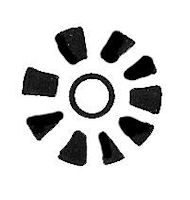
Stamped pottery did not leap fully-formed into being in Britain during the 4th century AD, as did Minerva from the head of Jupiter. Quite the contrary in fact, for there is a tradition of stamped pottery in certain areas of Britain that stretches back into the Bronze Age. There was a prolific period in the late Iron Age, particularly in the south of Britain, but the motifs used then seem to die out and are not favoured in the early Roman period.

This article will consider two rosette motifs that were common in both the 4th century and the post-Roman period: these are the A 5d and A 5fi motifs (Figs 1 and 2). The Classification of the Archive of Anglo-Saxon Pottery Stamps (hereafter AASPS) actually recognises sixteen varieties of the A 5d motif (a segmented negative ring surrounding a large positive circle), but because my study of the Roman period is based on published drawings for the most part, I have not tried to classify these examples below the sub-type level. The A 5fi motif is defined as a 'negative segmented ring containing inner positive and negative rings, all surrounding a central positive circle'.

To clarify my terminology in this article, the AASPS Classification divides stamps into Categories [A], Types [A 1], Sub-types [A 1b], Variations [A 1bi] and Sub-variations [A 1bi $]. Sub-variations only occur in very large Variation groups, where having a large number of similar Variation groups would cause problems in making an initial classification. When describing motifs, 'negative' means impressed into the fabric of the pot and so below the surface; 'positive' means that it is part of the surface of the pot. Anglo-Saxon potstamps are hardly ever 'proud' of the surface (as in samian ware).